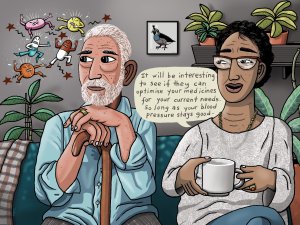For older people and frail people, the long-term benefit of medicines reduces and the potential for harm from adverse effects increases. When the benefit–risk balance changes in this way, medicine review and optimisation are important to simplify the therapeutic regimen, reduce inappropriate medicines and minimise risks. In this article, pharmacist prescriber Linda Bryant uses two case studies to illustrate important considerations during medicine reviews
The first time your team treats COVID-19 in the community
The first time your team treats COVID-19 in the community

It is looking increasingly likely that general practice teams will soon be managing cases of COVID-19 regularly in the community. GP Jo Scott-Jones discusses what this might look like and how you can support patients in their homes
Kia ora and welcome to New Zealand Doctor Rata Aotearoa
Not a subscriber? Unlock this article by subscribing here.
1. Ministry of Health. COVID-19: Current cases. 3 October 2021. https://www.health.govt.nz/our-work/diseases-and-conditions/covid-19-novel-coronavirus/covid-19-data-and-statistics/covid-19-current-cases
2. Ministry of Health. COVID-19: Science news. 31 August 2021. https://www.health.govt.nz/our-work/diseases-and-conditions/covid-19-novel-coronavirus/covid-19-resources-and-tools/covid-19-science-news#updates
3. Steyn N, Plank M, Hendy S. Modelling to support a future COVID-19 strategy for Aotearoa New Zealand. Auckland, NZ: Te Pūnaha Matatini, University of Auckland; 23 September 2021. https://www.tepunahamatatini.ac.nz/2021/09/23/modelling-to-support-a-future-covid-19-strategy/
4. Ministry of Health. Primary care quick reference guide. 6 September 2021. https://www.health.govt.nz/our-work/diseases-and-conditions/covid-19-novel-coronavirus/covid-19-information-health-professionals/covid-19-primary-care
5. Ministry of Health. COVID-19 Variants Update. 18 August 2021. https://www.health.govt.nz/system/files/documents/pages/18_august_2021_-_variants_update_-_full_report.pdf
6. Zhou F, Yu T, Du R, et al. Clinical course and risk factors for mortality of adult inpatients with COVID-19 in Wuhan, China: a retrospective cohort study. Lancet 2020;395(10229):1054–62.
7. US Food and Drug Administration. Emergency Use Authorization: Coronavirus Disease 2019 (COVID-19) EUA Information. 24 September 2021. https://www.fda.gov/emergency-preparedness-and-response/mcm-legal-regulatory-and-policy-framework/emergency-use-authorization#covid19euas
8. Yu LM, Bafadhel M, Dorward J, et al. Inhaled budesonide for COVID-19 in people at high risk of complications in the community in the UK (PRINCIPLE): a randomised, controlled, open-label, adaptive platform trial. Lancet 2021;398(10303):843–55.
9. Tardif JC, Bouabdallaoui N, L'Allier PL, et al. Colchicine for community-treated patients with COVID-19 (COLCORONA): a phase 3, randomised, double-blinded, adaptive, placebo-controlled, multicentre trial. Lancet Respir Med 2021;9(8):924–32.
10. Greenhalgh T, Knight M, A'Court C, et al. Management of post-acute covid-19 in primary care. BMJ 2020;370:m3026.



